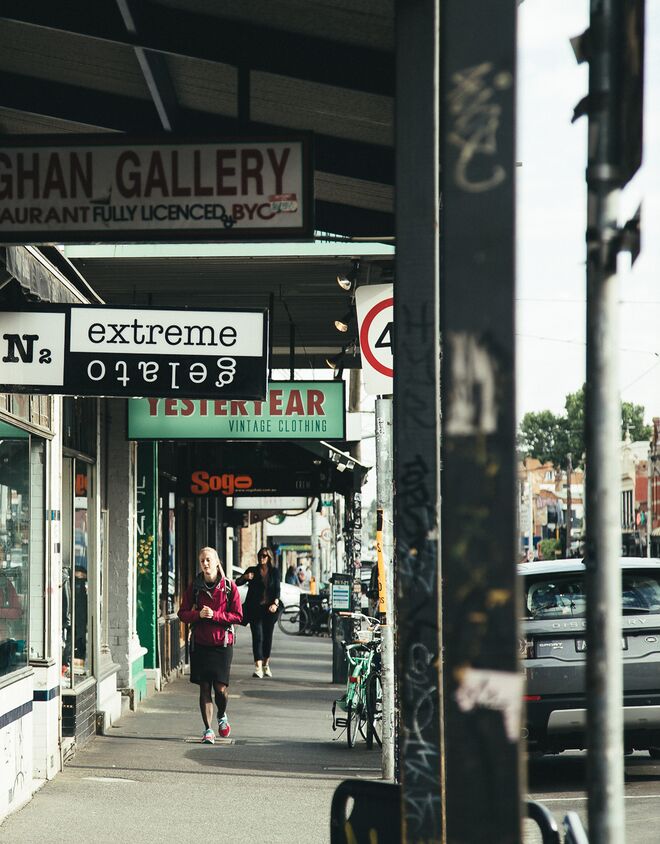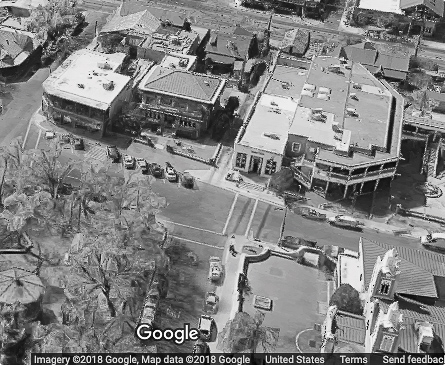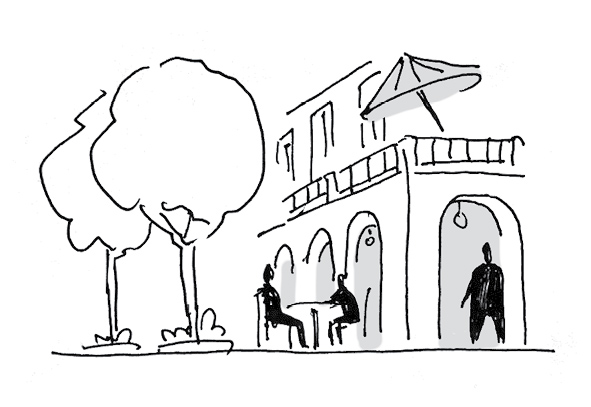9.2. Arcade Building
Aus Pattern Language Wiki
(Weitergeleitet von .../Arcade Building)
Along the edges of the Perimeter Block, there is a need to create a stronger connection between the buildings and the public spaces.
Problem-statement: In many areas, there is a need for shelter as well as transitional space between the private interior and public exterior. This can be done with galleries and other porch-like structures, designed as integral elements to the building exteriors.
Discussion: Arcade buildings are archetypal structures in many cities. We can think of the famous arcades of Bologna, or the galleries surrounding the plazas of the American Southwest (see photo on next page). They create sheltered places along the street, especially valuable when adjacent to (and overlooking) squares and other public spaces.
We now know that these buildings are archetypal for deep biological reasons. New findings in neuroscience reveal that humans prefer to use paths that also define a spatial sense of place. All animals avoid exposed open space, and prefer to move along protected edges and perimeter boundaries — a phenomenon known as thigmotaxis.¹ For people too, an arcade along the block perimeter provides a most welcoming enveloping space for pedestrian movement. This type of place, with its own characteristics, transitions between the interior of the building and the street. It defines an important intermediate region — one that was lost when well-adapted contextual buildings were replaced by “designed-object” buildings.
However, in designing arcade buildings, care must be taken when arcades front along retail uses that there is adequate visibility. This can be done by ensuring that there is sufficient height to the galleries so that there is adequate light on the retail spaces. In some contexts, however, the customer traffic volume is so high that this is not a concern.
1 Our colleagues Ann Sussman and Justin Hollander discuss this phenomenon and its relation to urban design at length, with additional research citations, in Sussman, A. & Hollander, J.B. (2015) Cognitive Architecture. New York: Routledge.
Therefore:
Create arcade buildings when there is a need to shelter people adjacent to public spaces, to promote architectural connectivity to the street and the public realm, or to allow gatherings at upper levels, such as restaurants overlooking squares.
Use Arcades built into the lower story of a building to make a pedestrian-friendly space. Create a Gallery Surround whenever possible, using porches, awnings and other structures. …
Image: Zoe Lin via Unsplash
Mehaffy, M. et al. (2020). ARCADE BUILDING (pattern). In A New Pattern Language for Growing Regions. The Dalles: Sustasis Press. Available at https://pattern-language.wiki/.../Arcade_Building
SECTION I:
PATTERNS OF SCALE
1. REGIONAL PATTERNS
Define the large-scale spatial organization…
1.4. 400M THROUGH STREET NETWORK
2. URBAN PATTERNS
Establish essential urban characteristics…
3. STREET PATTERNS
Identify and allocate street types…
4. NEIGHBORHOOD PATTERNS
Define neighborhood-scale elements…
5. SPECIAL USE PATTERNS
Integrate unique urban elements with care…
6. PUBLIC SPACE PATTERNS
Establish the character of the crucial public realm…
7. BLOCK AND PLOT PATTERNS
Lay out the detailed structure of property lines…
8. STREETSCAPE PATTERNS
Configure the street as a welcoming place…
9. BUILDING PATTERNS
Lay out appropriate urban buildings…
10. BUILDING EDGE PATTERNS
Create interior and exterior connectivity…
10.1. INDOOR-OUTDOOR AMBIGUITY
SECTION II:
PATTERNS OF MULTIPLE SCALE
11. GEOMETRIC PATTERNS
Build in coherent geometries at all scales…
11.2. SMALL GROUPS OF ELEMENTS
12. AFFORDANCE PATTERNS
Build in user capacity to shape the environment…
13. RETROFIT PATTERNS
Revitalize and improve existing urban assets …
14. INFORMAL GROWTH PATTERNS
Accommodate “bottom-up” urban growth…
15. CONSTRUCTION PATTERNS
Use the building process to enrich the result…
SECTION III:
PATTERNS OF PROCESS
16. IMPLEMENTATION TOOL PATTERNS
Use tools to achieve successful results…
16.2. ENTITLEMENT STREAMLINING
16.3. NEIGHBORHOOD PLANNING CENTER
17. PROJECT ECONOMICS PATTERNS
Create flows of money that support urban quality…
17.4. ECONOMIES OF PLACE AND DIFFERENTIATION
18. PLACE GOVERNANCE PATTERNS
Processes for making and managing places…
18.3. PUBLIC-PRIVATE PLACE MANAGEMENT
19. AFFORDABILITY PATTERNS
Build in affordability for all incomes…
19.1. INTEGRATED AFFORDABILITY
20. NEW TECHNOLOGY PATTERNS
Integrate new systems without damaging old ones…
20.2. RESPONSIVE TRANSPORTATION NETWORK COMPANY


